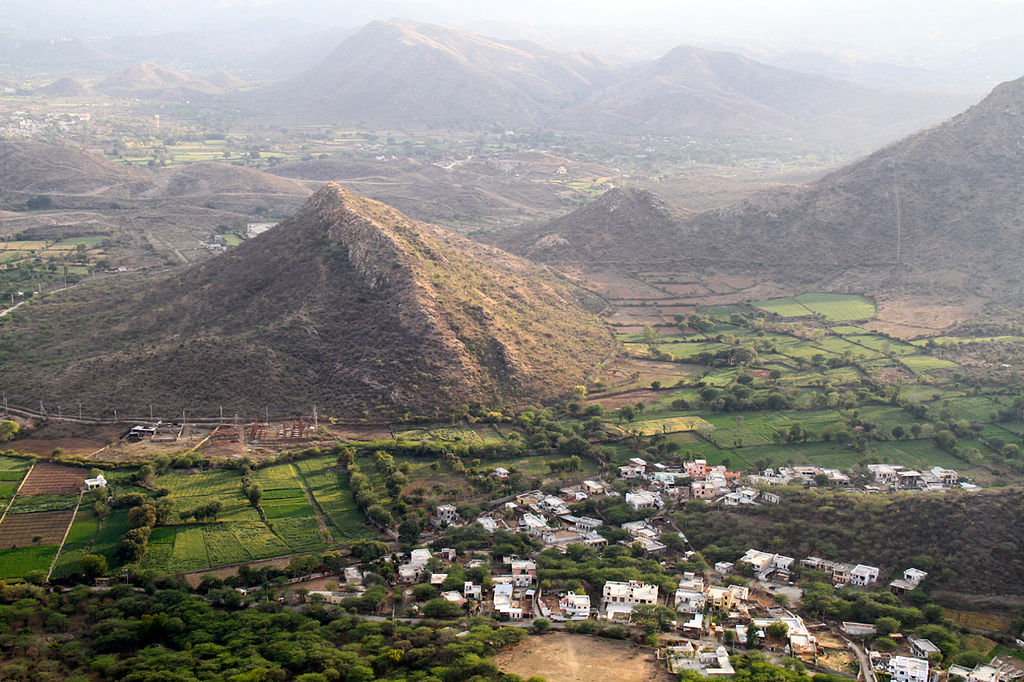

pya Rajasthan is a state northern India. It has an area of 342,240 square kilometers (132,140 sq. mi) or 10.5 percentage of the total geographical area in India. It is the largest state in India by area and seventh largest by population. Rajasthan is located on the northwestern part of India, where it comprises most of the wide and hostile THE THAR DESERT (also known as The Great Indian Desert) and it is bounded to the north and northeast by the states of Punjab and Haryana, to the east and the southeast by the states of Uttar Pradesh and Madhya Pradesh, to the southwest by the state of Gujarat and to the west and northwest by the province of Sindh and Punjab in Pakistan. The capital city is Jaipur, in the east-central part of the state. Its geographical location is 23.3 to 30.12 North Latitude and 69.30 to 78.17 East longitudes, with the Tropic of Cancer passes through South most part of the state.
Major feature includes the ruins of the Indus Valley Civilization at Kalibangan, the Dilwara Temple, one of the major Jain Pilgrimage site at Rajasthan's only hill station, Mount Abu, in the ancient Aravalli Mountain ---------Range and The Keoladeo National Park of Bharatpur, is one of the World Heritage Site known for its bird life. Rajasthan is also home to three National Tiger Reserves, The Rathambore National Park in Sawai Madhopur, Sariska Tiger Reserve in Alwar and Mukundra Hill Tiger Reservere in Kota.

Climate of Rajasthan:
Rajasthan has a wide range of climate that varies from extremely arid to humid. The humid zone spans the southeast and east part of the state; Except in the hills, the heat during the summer is intense all over, June is the warmest month typically temperature rising from 80 F (about 30 degree Celsius) to nearly 110F (low 40 degree Celsius) daily. Hot winds and dust storms occur in the summer, especially in the desert tract. January is the coolest of the winter month; daily maximum temperatures ranges from the upper 70F to the mid-80F (low to mid - 20degree Celsius), while minimum temperature generally goes up to 40F (about 7 degree Celsius). The western part of the desert has little rain, on average of about 4 inches (100mm) every year. However in the southeast, some areas may receive almost 20 inches (500mm). Southeastern Rajasthan gets benefits from both The Arabian Sea and Bay of Bengal because of branches of southwest monsoon winds, which brings the bulk of the annual rainfall.

Why Rajasthan is a Desert?
The Western part of Rajasthan is a desert because the temperature remains very high in summer and the Aravalli Mountains lie parallel to the moisture laden winds coming from The Arabian Sea Branch of the southwestern monsoons, thereby causing no orographic rainfall. When there is excess moisture in cloud that cannot hold further and suddenly upliftment of the cloud with same moisture. As cloud moves suddenly upwards it losses its moisture holding capacity. This happens in windward side of the mountain. These Aravalli Range are not blocking winds which carry moisture. They are parallel to the direction of the cloud movement, so there is no upliftment of clouds carrying moisture, since they don't obstruct the wind, there is no rainfall in the Western Rajasthan. Thus the deserts are formed.
Transport in the Desert:
The Camel is very essential for the people to use as a beast of burden for long and difficult journey through. Horses, or donkeys could not be able to sustain the miles of the distance the way the camel can do. It can own to its ability to not need constant water. Camel can move heavy goods like wood, fodder, gas cylinders, fabrics and bricks on two wheeled cart and these cart can generate enough daily revenue to support the family. In the Aravalli and Southern Rajasthan, camel is used to transport crops like chili peppers, lifting as heavy loads over long distances. Indeed, the camel is still an enduring part of Rajasthan Culture.

Biodiversity in Thar Desert
Fauna
The ship of the desert, Camels is the first animal come to mind while talking about wildlife safari in desert. Apart of this we can also find Indian Spiny Tailed Lizard, Saw Scaled Viper, Great Indian Spotted Eagle, Great Indian Bustard, Black Buck , Asistic wildcat, White footed Fox, Chinkara, Indian Desert Jird etc.

Flora
Some plants that live in the desert can live for hundreds of year. Types of plants that live in desert. Prickly Pear Cacti, Tumberweed, Saguaro Cactus, Mexican Poppies, Weathered Trees, Wildflowers, Oranges Trees, Ficus, Bismarck Palmetto, Pindo Palm. Cacti are able to survive and grow in the harsh , dry desert environment. The spines on a cactus help to protects it from humans and animals. Its roots are spread deep inside to collect water when it doesn't rain and it stores water in its body for future use.
Lifestyle of People living in Thar Desert :
Many people in the desert are nomads. Nomads rear cattle like goats, cows and camels. They keep moving from one place to another with their animals in search of food and water from them. Some of them are craftsmen and make their living by selling their goods. Some people grow crops like bajra, jowar , wheat and mustered seeds. There are also many industries ( textiles, sugar, cement, fertilizers, etc.)and mines ( lead, Zinc, iron-ore, etc.) that provide region with means of livelihood

Hope you like it. Please follow, comment, like my blog.
Happy Reading!!! Happy Blogging!!!


















